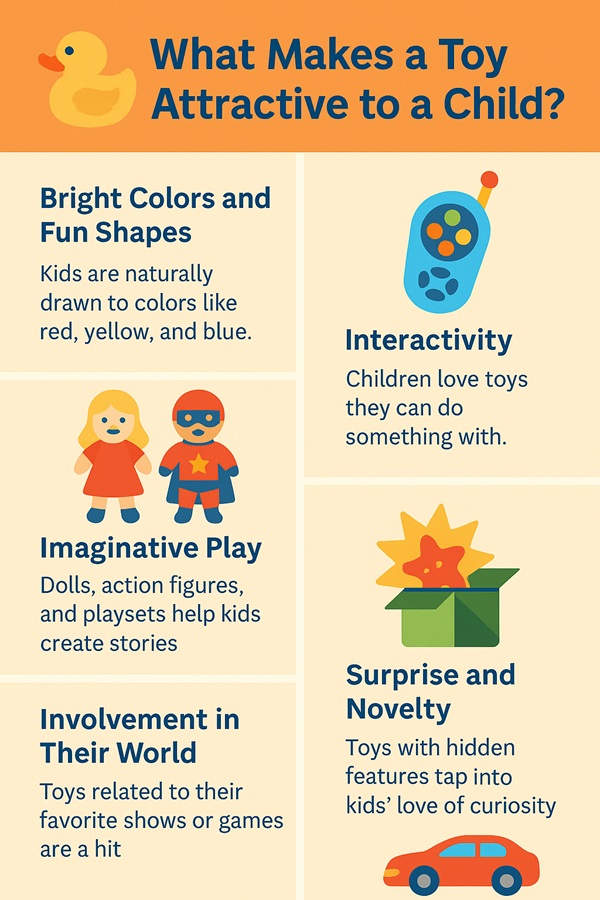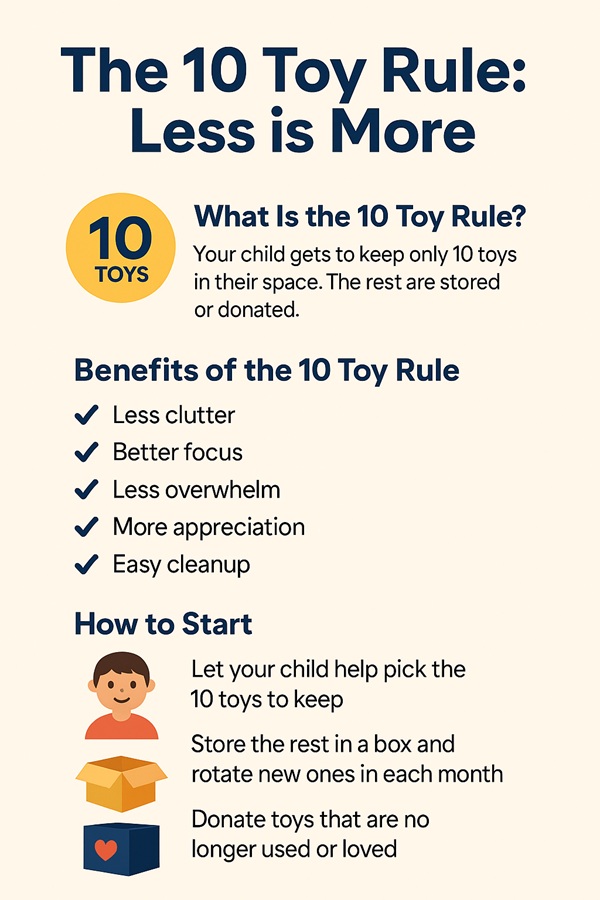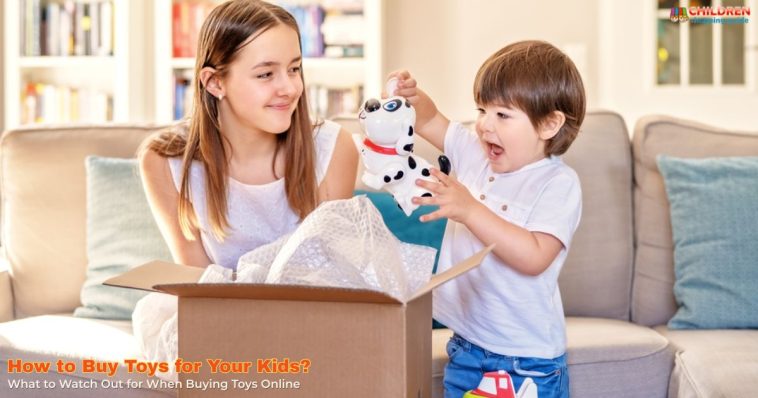Shopping for toys used to mean a trip to the store, watching your child’s eyes light up at the shelves stacked with colorful boxes. But today, most parents are turning to online stores for convenience, variety, and better prices. While buying online is easier in many ways, choosing the right toy for your child still takes some thought. With endless options just a click away, it’s easy to feel overwhelmed. So how do you know which toy is the right one?
This guide on how to buy toys for your kids online will break things down in a simple, practical way. We’ll look at the key factors parents should think about before clicking “add to cart”, what makes a toy truly exciting for a child, and even dig into the popular “10 Toy Rule.” Whether you’re shopping for a birthday, holiday, or just because, this article will help you make smarter choices—and maybe even avoid a few meltdowns.
Why Buying Toys Online Can Be Tricky
Buying toys online definitely has its benefits. You get more options, quick price comparisons, and helpful reviews from other parents. You can shop anytime without leaving the house, which is a lifesaver for busy parents. But as convenient as it is, there are a few things that make online toy shopping a bit tricky:
-
You can’t touch or feel the toy – Photos can be misleading. A toy might look big in the picture but turn out to be tiny. You also can’t test how it feels in your hand or how sturdy it is until it arrives.
-
Too many choices – Online stores show you hundreds (sometimes thousands) of results for a simple search like “toy for 4-year-old.” The variety can be overwhelming, and you may end up unsure of what’s actually best for your child.
-
Misleading descriptions – Product titles and photos are sometimes designed more for clicks than clarity. What you think is a full playset might just be a single figure, or the colors and features may not match what’s shown.
-
Age-appropriateness – Just because a toy is labeled for a certain age doesn’t mean it suits your child’s actual skill level or interests. Some toys may be too advanced or too simple, which can lead to frustration or boredom.
-
Delayed shipping or returns – If the toy isn’t what you expected, sending it back can be a hassle—especially if it came from a third-party seller or international shop.
That’s why it’s essential to take your time, read carefully, and consider a few important things before making a purchase. Doing a little homework upfront can save you money, time, and disappointment later.
Quick Checklist: What to Watch Out for When Buying Toys Online
| Checkpoint | What to Look For |
|---|---|
| Size & Dimensions | Double-check the toy’s measurements in the description. Photos can be misleading. |
| Product Title vs. Description | Read the full description to make sure you know exactly what’s included. |
| Age Recommendation | Make sure it matches your child’s development, not just their age. |
| Photos & Videos | Look for listings with real customer photos or video demos when available. |
| Parent Reviews ⭐⭐⭐ | Focus on reviews from people with kids the same age as yours. Read both pros and cons. |
| Return Policy | Check if the seller offers free returns in case the toy isn’t what you expected. |
| Safety Labels 🚫 | Look for certifications like ASTM, CE, or BPA-free for safer play. |
| Shipping Details | Note the estimated delivery time, especially if it’s for a birthday or holiday. |
What Parents Should Consider When Buying Toys Online
When figuring out how to buy toys for your kids, don’t just go with what’s trending or what looks cute on the screen. A toy may look fun, but that doesn’t mean it’s right for your child. Think about how the toy fits your child’s personality, learning style, stage of development, and safety needs. Making a thoughtful decision can help avoid disappointment—for both you and your child.
Here are the top factors to keep in mind when shopping online for toys:
1. Age Appropriateness
The first thing to look for is the age recommendation. Toys are designed with specific age groups in mind—not just for safety, but for engagement and skill level.
Tips to keep in mind:
-
Look for labels like “3+” or “6 months and up” in the product details.
-
Read through the reviews to see if other parents agree with the suggested age.
-
Remember that each child is unique—your child might enjoy toys above or below their age range based on their maturity or interests.
A toy that’s too advanced could lead to frustration, while one that’s too basic may get tossed aside quickly.
2. Safety First
Safety should always be the top priority, especially when buying for younger kids who like to explore with their mouths and hands.
What to look for:
-
Non-toxic materials and BPA-free plastics
-
Rounded edges (especially for babies and toddlers)
-
No small parts or detachable pieces if the toy is for children under 3 (choking hazard)
-
Labels or markings like ASTM, CE, or EN71, which indicate the toy has passed recognized safety standards
Always read the fine print and double-check the manufacturer’s safety guidelines.
3. Educational Value
The best toys do more than entertain—they also help your child learn and grow. Many modern toys are designed to support different types of development.
Toys that build specific skills:
-
Cognitive & problem-solving – Puzzles, logic games, STEM kits
-
Creativity – Art supplies, modeling clay, magnetic tiles
-
Language – Books, flashcards, talking toys
-
Motor skills – Ride-on toys, stacking rings, shape sorters
Look for toys that your child can grow into, with multiple ways to play as they develop new skills.
4. Durability
Children are not always gentle with their toys—especially toddlers who love to throw, drop, and chew on things. A well-made toy may cost more at first, but it saves money in the long run.
Signs of good quality:
-
Made from solid wood or thick, high-quality plastic
-
Reinforced seams and stitching on plush toys
-
Reliable joints and mechanisms for action figures or moving parts
Before you buy, check the product reviews for notes on how the toy holds up after regular play.
5. Child’s Interests
This is where you personalize your choice. A toy is more likely to be a hit if it aligns with something your child already loves.
Examples:
-
A child who loves animals might enjoy a vet playset or farm figures.
-
If they’re into building, a LEGO-style set or construction toy will keep them busy.
-
For kids who love pretend play, consider costumes, dollhouses, or kitchen sets.
When in doubt, involve your child in browsing (if age-appropriate) or watch what types of toys they gravitate toward at playdates.
6. Reviews and Ratings
Product reviews are one of your most valuable tools when learning how to buy toys for your kids online. They offer real-world insights you won’t find in the product description.
How to read reviews effectively:
-
Focus on reviews written by parents of kids the same age as yours.
-
Read the 3-star reviews—they often point out pros and cons.
-
Look for patterns in feedback (e.g., “smaller than expected” or “my toddler loved it”).
Be cautious of overly vague or generic reviews, which could be fake or paid.
7. Return Policy
Sometimes, even after all the research, the toy doesn’t meet your expectations—or your child simply isn’t interested in it.
Before purchasing:
-
Check the store’s return window (30 days is common, but not guaranteed).
-
See if returns are free or if there’s a restocking fee.
-
Make sure the item is shipped and sold by a trusted seller or brand.
Buying from sites with hassle-free return policies, like Amazon or Target, gives you peace of mind in case things don’t work out.
What Makes a Toy Attractive to a Child?
To understand how to buy toys for your kids, you also need to see the world from their point of view. What catches their eye? What makes them want to play again and again? It’s not always about the latest technology or the biggest box—it’s about how the toy connects to their senses, imagination, and interests. Here are the key elements that make a toy exciting and attractive to children:

1. Bright Colors and Fun Shapes
Kids are naturally drawn to bold, vibrant colors like red, yellow, blue, and green. These colors are easier for young eyes to see and are associated with fun and energy. Toys with unusual shapes, animal faces, or friendly expressions are even more appealing because they stand out and spark curiosity.
Example: A colorful stacking toy shaped like a giraffe is likely to catch a toddler’s eye faster than a plain wooden block.
2. Interactivity
Children love toys that respond to their actions. Whether it lights up, makes a sound, or moves when pushed, interactive toys give kids a sense of control and satisfaction.
Types of interactivity that attract children:
-
Buttons to press
-
Wheels to spin
-
Levers to pull
-
Pieces that snap or click together
These simple interactions help children explore cause and effect, keeping them engaged for longer periods.
3. Imaginative Play
Toys that encourage storytelling and pretend play are a big hit—especially with preschool and early school-age kids. These toys give children the tools to act out scenarios, build worlds, and explore emotions.
Great examples include:
-
Dolls, puppets, and action figures
-
Play kitchens, doctor kits, and costumes
-
Miniature cars, houses, and animal figures
These toys are attractive because they grow with your child, offering new ways to play as their imagination develops.
4. Surprise and Novelty
Kids love a good surprise. Whether it’s a toy that changes color in water or an unboxing toy with a hidden character, the element of surprise adds excitement and keeps kids coming back.
Why it works:
-
It taps into their curiosity.
-
It creates a “what will happen next?” moment.
-
It feels like a mini adventure or discovery.
Toys with surprises don’t always have to be fancy—sometimes just having hidden compartments or unexpected features is enough to thrill a child.
5. Involvement in Their World
If a toy is connected to something your child already enjoys, it’s instantly more appealing. Kids feel seen when they get toys that reflect their favorite shows, games, or books.
Examples:
-
A Paw Patrol toy for a fan of the show
-
A Mario figure for a child who plays Nintendo
-
A space-themed puzzle for a child who loves rockets
These toys let kids bring familiar characters and themes into their own play, making it more meaningful and engaging.
The 10 Toy Rule: Less is More
The 10 Toy Rule is a simple but powerful minimalist parenting strategy that encourages families to limit the number of toys their kids actively play with to just 10 at a time. Instead of filling shelves with dozens of options, this method promotes intentional play, less mess, and more focus.

What Is the 10 Toy Rule?
The concept is straightforward: your child chooses 10 toys to keep in their play area. The rest are either stored away for future rotation or donated. Once they lose interest in a toy or grow out of it, you can replace it with another from the storage bin or bring in something new. It keeps their environment fresh without being overwhelming.
Benefits of the 10 Toy Rule
Parents who use this method often notice big improvements in how their kids play and behave:
-
Less clutter – Fewer toys mean cleaner, calmer play spaces.
-
Better focus – Kids are more likely to fully engage with each toy when they aren’t distracted by too many choices.
-
Less overwhelm – A room full of toys can be stressful for kids. Simplifying their space helps reduce decision fatigue.
-
More appreciation – Children begin to treasure what they have instead of always wanting more.
-
Easy cleanup – Ten toys are way easier to pick up than thirty.
This approach supports healthy habits like responsibility, gratitude, and decision-making—skills that benefit children in all areas of life.
How to Start the 10 Toy Rule
You don’t have to overhaul everything overnight. Here’s how to ease into it:
-
Involve your child – Let them help choose their favorite 10 toys. This gives them a sense of ownership and control.
-
Box the extras – Store the remaining toys in a labeled bin or closet for easy access during rotation.
-
Set a rotation schedule – Every few weeks or once a month, let your child swap out a few toys. It makes old toys feel “new” again.
-
Donate as needed – If your child no longer plays with certain toys, consider donating them to others in need.
This rule works especially well for birthdays, holidays, or if you tend to shop often. It’s a great way to stay mindful about how to buy toys for your kids without overcrowding your home. It reminds kids that toys are meant to be played with—not just collected—and helps reduce the “more is better” mindset.
Best Practices for How to Buy Toys for Your Kids Online
Now that you know what to look for in a toy, putting that knowledge into action is the next step. Buying toys online can be quick and stress-free—as long as you follow a few smart shopping habits. These best practices will help you avoid disappointment and make sure your child ends up with a toy they’ll actually enjoy.
Here’s a handy checklist to keep in mind every time you shop online for toys:
✅ Before You Buy:
-
Check the age recommendation – Make sure it aligns with your child’s current age and abilities. If it’s a gift, consider asking the parent what the child is into right now.
-
Read the full product description – Don’t rely on the title alone. The details will tell you exactly what’s included, the size, materials, and whether batteries or assembly are required.
-
Look at photos from multiple angles – Zoom in on product images and look for user-uploaded pictures in the reviews to get a real sense of size and quality.
-
Read at least 5 reviews – Focus on a mix of star ratings, especially 3-star reviews, which tend to be the most balanced and honest.
-
Confirm return policy and shipping times – Check if the item can be returned easily and whether it will arrive in time for holidays, birthdays, or special events.
✅ After You Buy:
-
Watch your child’s reaction when the toy arrives – Are they excited? Confused? Indifferent? First impressions matter and can tell you a lot about what kinds of toys work best.
-
See how long they stay interested – If the toy holds their attention for more than a few days, it’s probably a good fit. If it’s forgotten quickly, note why—it might help guide future purchases.
-
Leave your own review – Share your honest feedback to help other parents make informed decisions. Mention your child’s age and what they liked or didn’t like about the toy.
Following these steps makes the entire process of how to buy toys for your kids feel less like guesswork and more like smart parenting.
Popular and Trusted Online Stores for Buying Kids’ Toys
To avoid scams or poor-quality toys, stick with well-known retailers. Here are a few reliable options:
| Store | Pros | Link |
|---|---|---|
| Amazon | Huge variety, fast shipping, many reviews | amazon.com |
| Walmart | Affordable prices, wide range of brands | walmart.com |
| Target | Good for trendy and educational toys | target.com |
| Fat Brain Toys | Focus on learning toys | fatbraintoys.com |
| The Entertainer (UK) | Popular UK-based toy shop | thetoyshop.com |
Make sure the site is secure (look for the padlock icon in the browser), and avoid buying from unknown sellers without reviews.
Signs That a Toy Is a Good Fit
Once you’ve bought a toy, these signs will tell you it’s a success:
-
Your child returns to it again and again.
-
It sparks their imagination and creativity.
-
They want to show it to others.
-
It survives more than one play session.
-
They use it in new and different ways over time.
Conclusion
Buying toys online can feel like navigating a maze, but once you understand what matters—like age appropriateness, safety, educational value, and your child’s interests—it becomes much easier. Knowing how to buy toys for your kids isn’t about picking the flashiest or most expensive product. It’s about choosing something that fits your child’s development, sparks joy, and provides value over time.
Whether you’re following the 10 Toy Rule to simplify your home or hunting for a perfect birthday surprise, online toy shopping can be fun and rewarding. Just remember to read the details, stick with trusted websites, and think from your child’s perspective. With a little thought, you can fill your home with toys that do more than entertain—they help your child grow, learn, and smile.
Sources:



